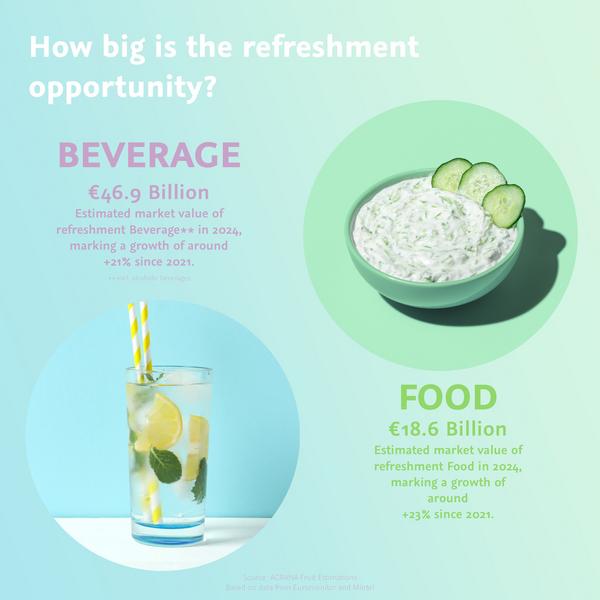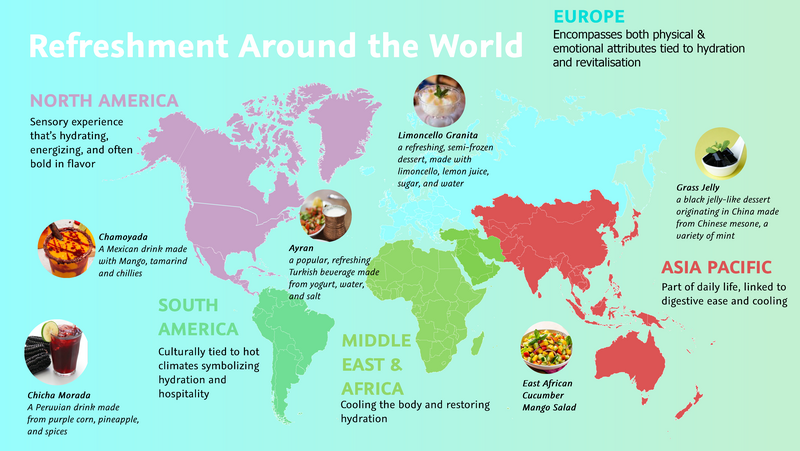Bringing the refreshment rainbow to food and beverages
Bringing the refreshment rainbow to food and beverages
Refreshment is more important now than ever
In a fast-paced world, refreshment has taken on new meaning and importance. With increasingly hectic lifestyles, people are seeking wellness-focused products that hydrate, energize, and fit seamlessly into their routines. This also leaves a growing desire for sensory escape or experiences that deliver a quick mental and physical reset through invigorating sensations. Combined with rising global temperatures, the demand for cooling solutions that offer physical relief is growing. Hence, consumers look for products that deliver either emotional, functional or refreshing benefits or a combination of these. But what is refreshment? A simple word and yet it carries a lot of meaning.
What is refreshment?
A process of restoring energy and relieving tiredness or discomfort! How could that be translated into the language of food and drink? A fizzy lemonade, A warm cup of chamomile tea, or a sip of a drinking yogurt, refreshment looks different for everyone, everywhere and every time. Although refreshment has historically been synonymous with beverages, its association with food is also quite significant. The global food and beverage refreshment market opportunity is estimated to be valued at 65.5 billion Euros. (estimations based on data from Euromonitor and Mintel).
What does refreshment mean for consumers?
Whether refreshment comes from a Chamoyada, a refreshing drink from Mexico made with mango, tamarind, and chilies, or a kefir depends on a multitude of aspects. However, the key drivers for it are: sensory and emotional aspects; flavor and color associations; and personal experience. What you find refreshing on a warm summer’s eve might not be the same as what you find refreshing on a chilly autumn morning. Furthermore, culture and context play a crucial role in what consumers find refreshing. For example, consumers in China consider Mango to be a refreshing flavor in yogurts and ice cream whereas European consumers have a stronger affinity towards lemon and berries. (source: The world of fruits white paper | AGRANA). In regions with high temperatures round the year, refreshment is linked more to cooling, hydration and digestive ease. In contrast, regions with colder climates consider refreshment as a means of mental revitalization and energizing.
How to deliver refreshment to consumers?
Refreshment is a multi-faceted experience that can be brought to life with:
- Sensory experience: a combination of cool temperatures, crisp or juicy textures, light and vibrant flavors like grapefruit or white peach, and aromatic cues that awaken the senses and evoke a feeling of invigoration.
- Functionality: building upon the sensory aspects of refreshment and adding functional benefits that meet the consumer need for energizing foods and drinks. Functional refreshment comes in different forms. Ingredients that provide benefits such as immunity boost, energy replenishment, muscle recovery, gut health and of course hydration are a perfect complement for refreshing flavors.
- Mental and Emotional appeal: Calming teas, botanicals and herbs, the “quieter” side of refreshment that addresses the desire for a quick sensory.
How can preparations help?
Preparations simplify product development by offering ready-to-use solutions that combine flavor, texture, color, and functional ingredients in a single, customizable format. By integrating seamlessly into various types of product applications like yogurts, ice creams, sorbets, beverages, bakery and so much more, preparations can bring refreshment to your consumers faster.
Bringing refreshment to life!
Looking to craft the ultimate refreshing concept for your consumers? We would love to collaborate with you in bringing refreshment to life with our market insights, decades of expertise in developing revitalizing food and beverage solutions that truly resonate.
Download the presentation below and lets get in touch!

